
The U.S. Army last week updated its 2020 cloud plan to reinforce its objectives of digital modernization and integration of key services into one global cloud environment – cARMY – an Army spokesperson confirmed to MeriTalk.
The service branch also said it was taking steps to put in place a related $1 billion cloud contract vehicle that the Army hopes can serve as a “easy button” for cloud access and cut the time for that process to a few weeks – from several months currently.
The 2022 Army Cloud Plan features seven new strategic objectives:
- Expand Cloud;
- Implement Zero Trust Architecture;
- Enable Secure, Rapid Software Development;
- Accelerate Data-Driven Decisions;
- Enhance Cloud Operations;
- Develop the Cloud Workforce; and
- Provide Cost Transparency and Accountability.
The Army said reaching those strategic objectives for cloud operations will allow it to reduce the digital footprint of the warfighters network on the ground, and integrate services to enable multi- domain operations.

“The Army through (the Enterprise Cloud Management Agency) has established the foundation for Army-wide adoption of cloud through cARMY at both secret and unclassified levels,” Dr. Raj Iyer, the Army’s chief information officer (CIO), said.
The plan provides a roadmap and metrics to measure progress in maintaining digital overmatch over U.S. near-peer adversaries and a sustainable strategic path to the Army of 2030 – a goal to match soldiers to positions where they will perform best, and curating highly trained, disciplined, and fit fighters.
Significant progress towards the Army’s vision has already been made, and many of the core principles of the 2020 cloud plan remain steadfast, according to a recent press release.
At the same time, the Department of Defense’s land service branch announced requirements for a $1 billion contract vehicle that will provide commands with an easy way to migrate their existing systems to the cloud.
The Army hopes to award the forthcoming contract vehicle – called Enterprise Application Modernization and Migration – as an indefinite-delivery, indefinite-quantity agreement, with spots for multiple vendors, by the second or third quarter of the current fiscal year, Iyer said.
“This is going to become the easy button for the Army to actually move to the cloud,” the CIO said at a media round table during the Association of the U.S. Army annual conference last week.
Iyer made the point that commands looking to move to the cloud now have to do a lot of shopping because there’s not an umbrella contract they can utilize to help the process run more smoothly, quickly, and at less cost.
He said this process can often take up to nine months currently, and by that point, their budgets have run dry.
“The intent here is four weeks to award a task on this contract and my office is going to own this vehicle,” Iyer said. “We’re really kind of holding their hand to help them migrate the applications in the cloud all the way from architecting it, working through migrating the data, to the contract vehicle and so on.”
